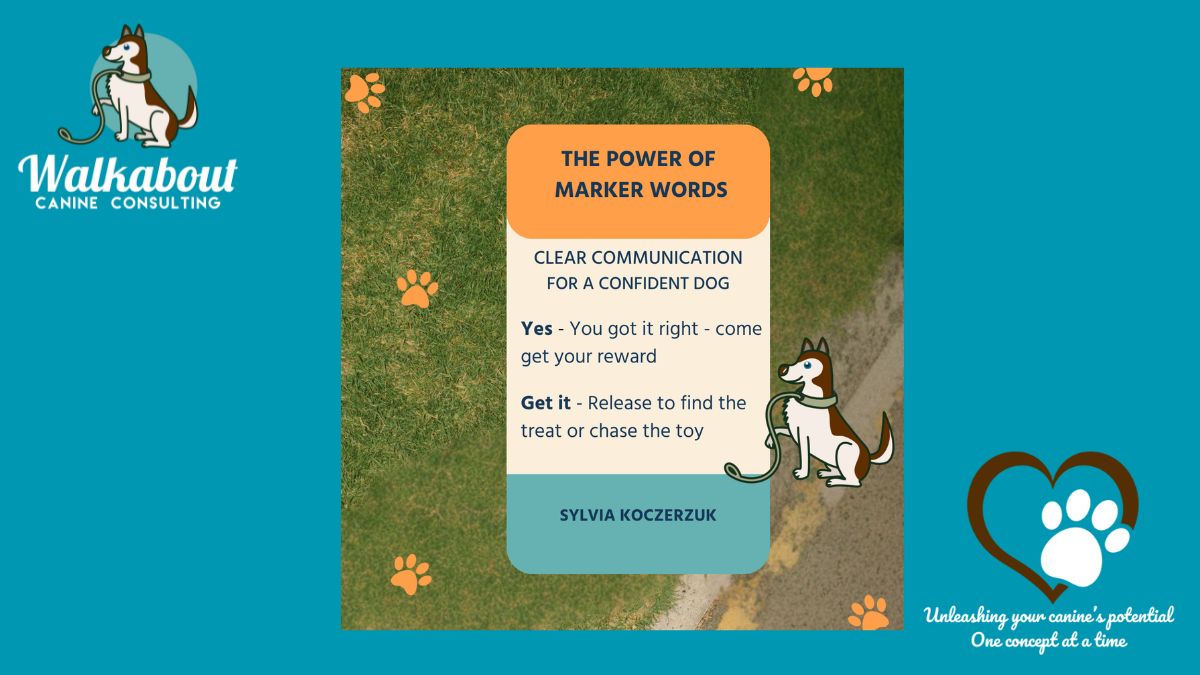Positive Dog Training & Behaviour Blog | Walkabout Canine Consulting
Unleashing your dogs potential, one concept at a time
Dog Training - Marker Training your dogs GPS

Learn how to use marker words in dog training to build confidence, clarity, and connection — without a clicker.
🎙️ SCRIPT: Understanding Marker Words – Your Dog’s GPS for Learning
"Dogs live in a world of pictures and associations. Marker words help us take a snapshot of the exact moment your dog gets something right — so they know it too."
Hi, I’m Sylvia, and today I want to introduce you to one of the most powerful tools in dog training — marker words, also known as bridging cues. Think of them as your dog’s GPS system. They help your dog know when they’ve arrived at the right behaviour — and that something good is coming their way.
I don’t use a clicker. Not because I dislike it — it’s simply not my go-to. I prefer to teach with my voice. It’s accessible, it's portable, and most importantly, your dog already listens to your voice every day. So why not harness that connection?
🎯 What is a Marker Word?
A marker word is a consistent verbal cue that marks the exact moment your dog does the behaviour you want — it bridges the gap between the behaviour and the reward.
Here’s a simple analogy:
Imagine you’re taking a photo. Your marker word is the shutter click — it captures the behaviour, and the reward is the photo getting printed.
🗣️ Types of Marker Words I Use:
I use a layered marker system — and you’ll get to know each one over time. Here are some examples:
-
"Yes"/ "Nice" – This is a terminal marker. It means “You got it right — come get your reward!” Often used when the dog will move to you for the treat.
-
"GGGGood" – A duration marker. It means “Keep doing what you’re doing; reward is coming.” Think of a dog lying calmly on a mat — we want to stretch that out.
"Get it" – Can be used to release the dog to go get a tossed treat, or acknowledge a behaviour that is ‘done’ but not needing precision.
-
"Oops" – A gentle reset word. Not a punishment, just information: “That wasn’t quite it — let’s try again.” I do not use this too much ....maybe more like is that where you are meant to be if they wander away or off their boundary.
"Thank you" (not a marker but another way to acknowledge when you dog is not needing food rewards) – Can be used as a marker and or verbal reward.
💡 Why I Don’t Use a Clicker
I love the science behind the clicker — but I find marker words more practical for most families. They allow for tone variation, are intuitive to use, and strengthen emotional connection. You’re not just training — you’re communicating.
For dog guardians who want a smoother day-to-day life — not a competition routine — marker words provide a flexible, reliable way to help dogs feel successful.
⏱️ Timing is Everything
Your marker should come right as the behaviour happens, not after. You’re creating a bridge between: Behaviour → Marker → Reward
So if your dog sits, you say “Yes” as the bum hits the ground, not after you’ve fumbled for a treat.
🧩 Why Marker Words Beat Guessing Games
Dogs are excellent observers, but they’re not mind-readers. When we don’t provide a clear signal that they’ve done something right, they’re left to guess. Guessing often leads to frustration — and frustrated dogs check out, escalate, or give up.
Marker words eliminate the guesswork. Instead of offering a dozen behaviours to see what works, your dog gets immediate feedback. It’s like giving them a gold star in the exact moment they succeed — and that kind of clarity creates momentum in learning.
The result? Fewer repetitions, stronger behaviours, and a more joyful training relationship.
✅ Why This Works:
-
It gives clarity: Your dog knows exactly what worked.
-
It builds confidence: You’re speaking a language they can learn quickly.
-
It reduces frustration: No more guessing games — dogs love clear feedback!
🚫 Common Mistakes:
-
Using inconsistent words (saying “yup” one day, “yes” the next).
-
Delayed timing — marking after the behaviour has passed.
-
Using your marker as a cue (e.g., saying “yes” to get your dog to do something).
🧠 Let’s Practice
In our sessions, I’ll show you how to start with:
-
One marker word (usually “Yes” or “Get it”)
-
Pair it with food, play, or another reinforcer
-
Repeat it in easy settings, like when your dog looks at you
Over time, we’ll layer in multiple marker words to grow your dog’s understanding and confidence.
🐾 Final Thought
Marker words are more than just training tools — they’re communication bridges. They help you become a better listener and observer of your dog. And they help your dog feel seen, successful, and safe.
📣 Ready to Try It?
Need help choosing the right markers or timing them in real-life situations like resource guarding, reactivity, or general manners? I’m here to help.
Book a discovery call with me at www.walkaboutcanineconsulting.org
Let’s create a communication system your dog actually understands.
Categories: : bridging cues, dog behaviour communication, dog training without clicker, force-free dog training, marker words dog training, positive reinforcement training, Sylvia Koczerzuk dog trainer, verbal marker cues
 Sylvia Koczerzuk Koczerzuk
Sylvia Koczerzuk Koczerzuk 
